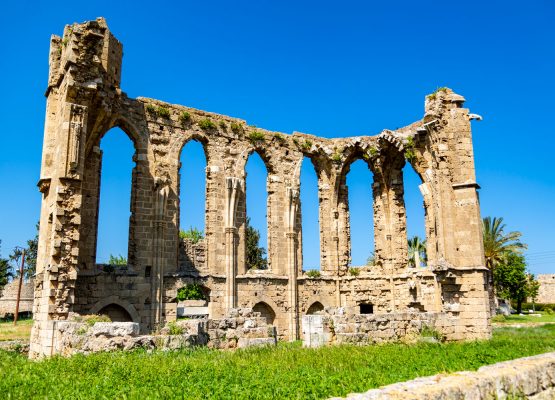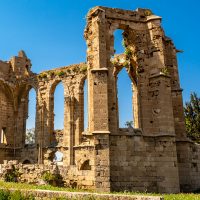
Inspired by Sainte-Chapelle
Sitting perhaps incongruously amid a traffic intersection, St. George of the Latins is one of Famagusta’s oldest churches.
Located in the northern part of the old city, close to Othello’s Tower, the remaining walls with their distinctive lancet windows are a great example of early Gothic architecture.
Though the precise date of its construction is unknown, evidence of a fortified parapet where defenders could protect the church, indicates that St. George was built at a time when the Lusignans had not yet completed the city walls – most likely in the last quarter of the 13th century, using materials removed from Salamis.
Its design is said to be inspired by the Sainte-Chapelle in Paris, considered among the highest achievements of the Rayonnant period of Gothic architecture, and consecrated in 1248.
Despite what remains today is predominantly the northern and eastern walls of this church, the remnants indicate what the edifice may have looked like in its prime.
Thin columns built into the walls were usually elaborately carved with religious figures or with coats of arms belonging to the benefactors of the church.
Areas of the walls between the pillars were structured to be relatively free of weight, one of the main features of Gothic architecture, granting huge windows and substantial sunlight to enter the church.
In the south west corner, the first steps of what was a spiral staircase leading up to the roof can be seen, and to the north west, remnants of a guard house with a conical roof, the entrance doorway still unmistakable.
Following the line of the roof and you can still see some of the protective wall, complete with arrow slots, another reason that has lead researchers to be believe that the church was built in the period before the city walls were completed.
As was the case with most of the towering buildings, the city walls did not provide complete protection and the church suffered damage during the Ottoman siege of 1570 – 1571, some of which can still be observed on the eastern wall of the church.
The only entrance which survives is to the north, and this is comparatively well preserved. It is surrounded by carvings – a gargoyle in the form of a monk opening his mouth with his hand, most likely used to drain water from the walls, and also of a lion devouring a lamb.
Not to be confused with the similarly named St. George of the Greeks church which is a few minutes’ walk to the east of this spot, your route will almost certainly take you past this intriguing site.





